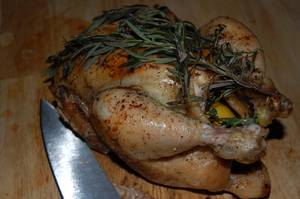Dissecting Christmas Dinner
Interview with
John - Now, the result is a lovely tasting bird but the muscles are completely useless for flying. It's just too big. It's lost all its natural strength. And it's only good for eating. Now, the other one we mentioned, the deeper one, that's used for the up stroke. So that does the opposite movement. When a bird wants to beat its wings back up but after the down stroke, it uses that smaller one.
So these are two pectoral muscles.  And they're used in flying. Now the other thing that we've exposed by separating the meat along the midline, very easy to do, are several things. First of all, right in the midline, and if your Christmas listeners are doing this, you'll see a ridge, a ridge of bone. Actually in this chicken, it's a ridge of cartilage. It should be bone.
And they're used in flying. Now the other thing that we've exposed by separating the meat along the midline, very easy to do, are several things. First of all, right in the midline, and if your Christmas listeners are doing this, you'll see a ridge, a ridge of bone. Actually in this chicken, it's a ridge of cartilage. It should be bone.
Helen - Oh, right.
John - But nearly all chickens are slaughtered so early in their lives, all of them.
Helen - So actually because it's young, it hasn't become bone yet.
John - Exactly. It's not yet trying to turn into bird.
Helen - Right.
John - So it's just gristle. So that's one thing.
Helen - Almost up to where the muscles are attached to. Is that why it's there?
John - That's where they're attached to. And that's why it is so deep. It's actually about two centimetres deep because this great big great muscle is attached into it. But anyway, that's one of the things we could see in the midline. Now if we move towards the front, towards the neck of the chicken, we see something else which everybody well know: that is the wishbone.
Helen - Right. That V-shaped bone.
John - That V-shaped bone right at the front. In fact, technically, this is called the little fork or forcula. I mean, it is a fork. It's shaped like a fork. Anyway, that's one of two sets of collarbones the birds have.
Helen - Oh, so this is the bird's collarbone.
John - That's right.
Helen - Right.
John - That's the little collarbone. And actually, it doesn't do much. But deep down under that second layer of muscle I mentioned earlier is a second set of collarbones. These are much stronger. And they're essential for flight.
Helen - Is there two collarbones because there's two sets of muscles?
John - There are two collarbones because the wishbone itself is a bit of an apology. It won't really do the job, which any flying bird needs to, which is to stop its shoulders crunching towards its breast when it makes a powerful beat. And the function of that deeper collarbone is to stop that happening.
Helen - So would we get an even better wish if broke the inner collarbone?
John - I knew we would. You would be. It takes a bit of getting to. And I think by then, you'll be so tempted to eat this thing that I think you would have forgotten the functional aspect.
Helen - Well we certainly are getting into the grips of this chicken. And if we were looking at a turkey, would it be very different, or would it have a structurally very similar once you get inside them, or goose, or a duck?
John - Yeah. There are differences, many on accounts of size. Now the turkey's going to be very similar to the chicken whereas the goose is going to be quite different.
Helen - Right.
John - The turkey and the chicken have white meat. It has a distinctive taste because it's full of something called glycogen.
Helen - And that's what makes... So we have white and red meat. Is that right?
John - That's right.
Helen - Yes. Why are those different?
John
They're different as I say, the white meat has glycogen. And they're tend to be used when a muscle beats very quickly but exhausts very quickly as well.
Helen - So it's for a very, very fast moves. Right.
John
- Previous Acoustic Archaeology
- Next Did Swine 'Flu Escape from a Laboratory?









Comments
Add a comment